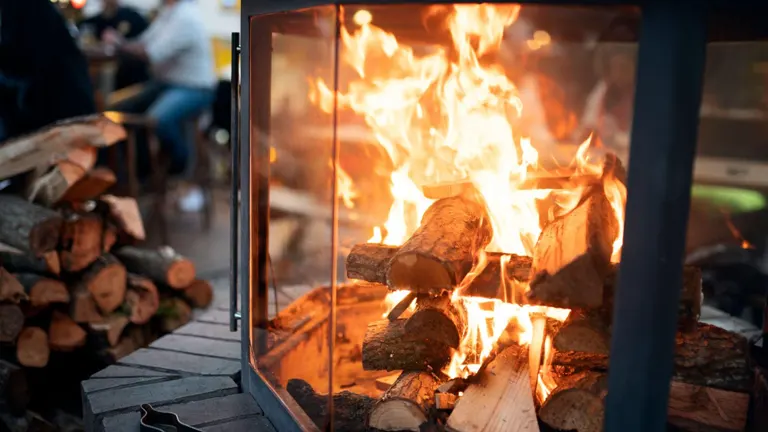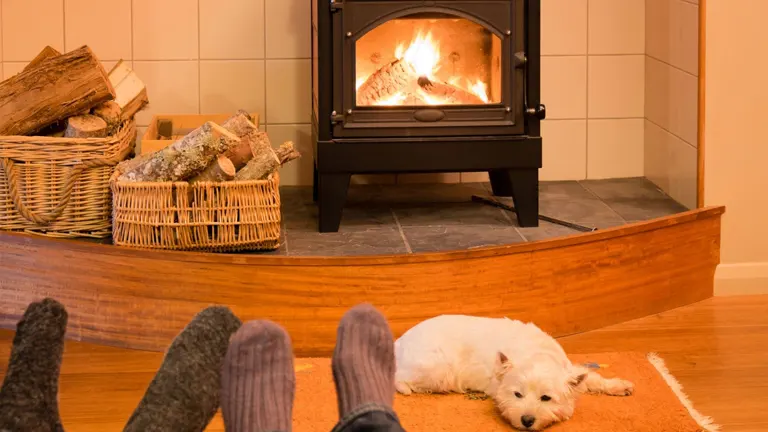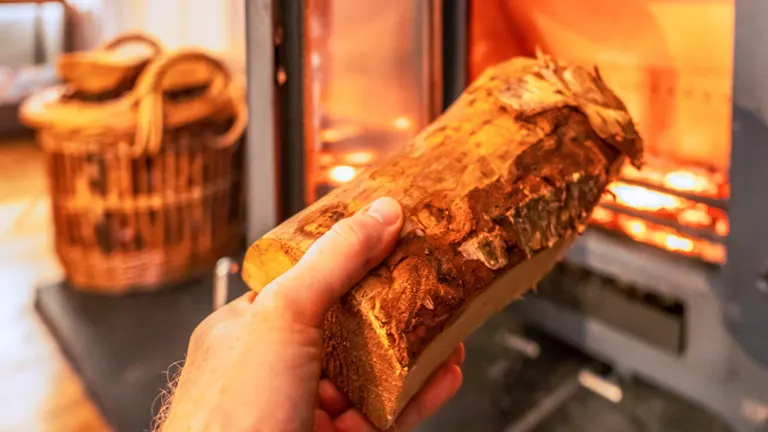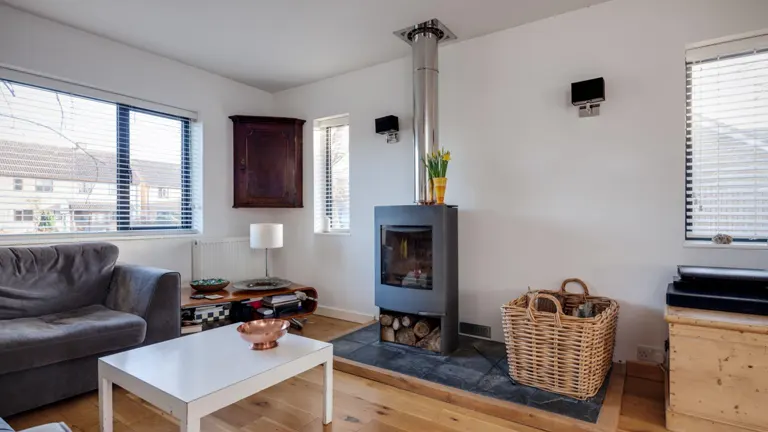Wood Stoves and Indoor Air Quality: What You Need to Know
- October 25, 2023
- 3 comment
Wood stoves have a special place in many homes. Their warm glow and comforting heat make chilly evenings more bearable and gatherings more intimate. But while they serve as a source of warmth and ambiance, it’s crucial to understand the other side of the coin: how they might impact the air we breathe inside our homes.

Even though they might seem harmless, these stoves can change our indoor air quality, both in noticeable and subtle ways. Knowing what happens behind the scenes can help us make smarter choices and ensure that our homes remain both cozy and healthy. In this article, we’re going to take a closer look at wood stoves, explore their effects on indoor air, and offer easy-to-follow tips to ensure the best of both worlds.
Let’s dive deep and ensure that we’re making the most of our wood stoves while prioritizing our health and well-being.
1. Combustion By-Products
When wood is burned as a fuel, it undergoes a complex series of chemical reactions. While the heat and light produced can be beneficial for home heating, the by-products of this combustion process can significantly influence indoor air quality.

Particulate Matter (PM2.5 and PM10)
- What is it? Particulate matter is composed of tiny particles or droplets in the air that can be inhaled into the lungs. PM2.5 represents particles with a diameter of fewer than 2.5 micrometers, while PM10 includes particles of less than 10 micrometers.
- Why is it concerning? Due to their minuscule size, these particles can bypass our respiratory system’s natural defenses and reach the deep lung tissues. Over time, consistent exposure can cause or worsen respiratory diseases such as asthma and COPD. Additionally, some particulates may carry toxins or act as carriers for other pollutants.
Carbon Monoxide (CO)
- What is it? Carbon Monoxide is a by-product of incomplete combustion. Unlike carbon dioxide (which is naturally exhaled during breathing), CO is a poisonous gas.
- Why is it concerning? CO molecules bind to hemoglobin in our blood more readily than oxygen. When this happens, it reduces the blood’s ability to transport oxygen to vital organs and tissues. Symptoms of CO poisoning can range from mild headaches and dizziness to confusion, unconsciousness, and in extreme cases, death. Properly functioning and ventilated wood stoves minimize CO production and its release indoors.
Volatile Organic Compounds (VOCs)
- What are they? VOCs encompass a wide range of organic chemicals that have a high vapor pressure at room temperature, meaning they can easily evaporate or sublimate into the air.
- Why are they concerned? Once released into indoor air, VOCs can cause a range of health effects. Some might cause short-term symptoms like eye, nose, and throat irritation, while others may lead to headaches, nausea, or damage to the liver, kidney, and central nervous system. Chronic exposure to certain VOCs is also linked to an increased risk of cancer.
Polycyclic Aromatic Hydrocarbons (PAHs)
- What are they? PAHs are a group of over 100 different chemicals formed during the incomplete burning of coal, oil, gas, wood, or other organic substances.
- Why are they concerned? Some PAHs have been identified as carcinogenic, mutagenic, and teratogenic, meaning they can cause cancer, genetic mutations, or harm to the fetus. The risk associated with PAH exposure depends on the specific compound, its concentration, and the duration of exposure. However, minimizing exposure, especially in living spaces, is crucial for health.
Being aware of these by-products and understanding how to manage them is essential for those who use wood stoves. Properly installing, maintaining, and operating wood stoves can minimize these by-products and their associated risks.
2. Ensuring Proper Ventilation
For centuries, humans have recognized the importance of ventilation when it comes to burning wood indoors. The modern home, designed to be energy-efficient and well-sealed, can become a trap for harmful pollutants if wood stoves aren’t correctly vented.

Upward Draft
- What is it? The principle of the upward draft, also known as the chimney effect or stack effect, is rooted in basic physics. Hot air, being less dense, rises, while cooler air sinks. When burning wood, the hot gases produced are lighter than the surrounding air, causing them to ascend.
- Why is it crucial? An efficient upward draft ensures that all the combustion by-products, including particulate matter, CO, VOCs, and PAHs, are directed away from the living spaces and released safely outside. A strong draft also ensures that the wood burns efficiently, reducing the production of harmful by-products. In the absence of a proper upward draft, there is a risk of back-drafting, where these harmful pollutants spill back into the room instead of going up the chimney.
Sealing Leaks
- What does it entail? Over time, stoves and chimneys can develop tiny openings or gaps, either from the wear and tear of components, structural shifts, or degradation of sealants. These potential leak points need to be regularly identified and addressed.
- Why is it important? A well-sealed stove system ensures that the combustion process is controlled and predictable. Leaks can upset the balance of air intake and exhaust, which can lead to inefficient burning and increased production of harmful by-products. Furthermore, gaps or leaks can allow pollutants to enter living spaces directly, posing immediate health risks. For instance, a leaky door seal might permit smoke (loaded with PM, VOCs, and CO) to escape the combustion chamber and infiltrate the room.
To Ensure Proper Ventilation
- Regular Maintenance: Schedule periodic inspections and cleaning of your chimney and stove. Over time, creosote, a flammable by-product of wood combustion, can build up in the chimney and impair the draft.
- Use the Right-sized Flue: The flue’s diameter and height should be compatible with the stove’s size and specifications. An improperly sized flue can hinder the upward draft.
- Monitor Stove Performance: If you notice excessive smoke, unfamiliar odors, or changes in the stove’s burning efficiency, it might indicate ventilation issues. Address them promptly.
3. Modern Stoves vs. Older Models
Wood stoves, like many appliances, have seen transformative technological advancements over the years. From rudimentary fire chambers in earlier eras to the sophisticated designs of today, the journey of wood stoves is a testament to our endeavor to achieve better efficiency and environmental responsibility.

Efficiency in Combustion
- Older Models: Traditional wood stoves typically had a straightforward design, which often resulted in incomplete combustion. This inefficiency not only wasted fuel but also led to higher emissions of unburnt particles and gases.
- Modern Stoves: Contemporary designs prioritize complete combustion. This not only means more heat from less wood but also a significant reduction in harmful by-products. Advanced air intake systems, better insulation, and improved firebox designs all contribute to this efficiency.
EPA Certification
- What is it? The Environmental Protection Agency (EPA) has set specific emission standards for wood stoves sold in many regions. To earn this certification, a wood stove must undergo rigorous testing to ensure it releases minimal pollutants into the atmosphere.
- Why is it important? An EPA-certified stove is a guarantee of its environmental responsibility. It signifies that the stove burns cleanly, ensuring that you’re not only keeping your indoor air cleaner but also contributing less to outdoor air pollution.
Catalytic Combustors
- What are they? A catalytic combustor is a device incorporated into some modern wood stoves. It consists of a honeycombed ceramic structure coated with metal catalysts, usually palladium or platinum.
- How do they work? As smoke and combustion by-products pass through the combustor, the catalyst triggers a chemical reaction, even at lower temperatures, which breaks down pollutants into less harmful substances. Essentially, the combustor ensures that more of the smoke is burned, further reducing emissions and boosting the stove’s efficiency.
- Benefits: Stoves with catalytic combustors can achieve combustion efficiencies of up to 90%. This not only means cleaner emissions but also extended burn times and consistent heat output. However, it’s worth noting that the catalyst can degrade over time and might require replacement to maintain peak performance.
While older wood stoves have a rustic charm and nostalgia attached to them, modern stoves are undeniably superior in terms of efficiency, environmental impact, and user convenience. If you’re considering installing a wood stove or replacing an older model, it’s worthwhile to invest in contemporary designs with EPA certification and, if possible, catalytic combustion technology. Not only will you save on wood costs in the long run, but you’ll also enjoy a warmer, cleaner home and a clearer conscience about your environmental footprint.
4. Best Practices for Clean Burning
The performance of your wood stove is not just dependent on its design and construction, but also on how you use it. By adopting certain best practices, you can minimize emissions, improve efficiency, and extend the lifespan of your stove.

Burn Only Dry, Seasoned Wood
- Why is it essential?: Freshly cut or “green” wood contains a high moisture content. When burned, this moisture needs to evaporate, consuming a significant portion of the energy produced during combustion. This results in lower burn temperatures, incomplete combustion, and increased smoke production.
- How to ensure your wood is seasoned?: Wood should be split, stacked, and allowed to dry for at least 6-12 months before use. The exact duration can vary based on the wood type and local climate conditions. To check for dryness, knock two pieces of wood together; dry wood will produce a sharp “clink” while green wood will sound more like a dull “thud.” Additionally, seasoned wood often has cracks at the ends and feels lighter.
Avoid Overloading
- Why is it a concern?: While it might be tempting to load up the stove for a long burn, overloading can suffocate the fire, reducing the oxygen supply necessary for complete combustion. This can lead to smoldering fires that produce excessive smoke, creosote, and other pollutants.
- The right way to load: Use smaller, more frequent loads to maintain an active, vibrant flame. The goal is to achieve a hot, efficient fire that consumes the wood fully, leaving minimal unburned material.
Regular Maintenance
- Why is it important?: Just like any other appliance, a wood stove needs regular care and attention. Proper maintenance ensures that the stove operates efficiently and safely.
- Creosote buildup: Creosote is a sticky, tar-like substance that forms when wood smoke cools and condenses. Over time, it can accumulate on the walls of your stove and chimney, reducing airflow and posing a significant fire hazard. Burning green or wet wood can accelerate creosote formation.
How to Maintain your Stove
- Regular Cleaning: Empty the ash pan regularly to ensure optimal airflow. Use a chimney brush or hire a professional chimney sweep to clean the flue and remove creosote deposits.
- Inspect Seals and Joints: Ensure that door gaskets, seals, and stove joints are intact. Replace any worn-out parts promptly.
- Check for Rust and Corrosion: Regularly inspect the stove’s exterior and interior for signs of rust or corrosion. Addressing these early can prolong the stove’s lifespan.
5. Indoor Air Purifiers
While ensuring your wood stove operates efficiently is crucial, it’s also wise to acknowledge that indoor air pollution can come from various sources. Whether it’s from household cleaning products, outdoor pollutants seeping in, or minor emissions from your wood stove, the air inside your home can benefit from filtration. This is where air purifiers come into play.

How to do Air Purifiers Work?
The basic premise of an air purifier is to circulate indoor air through one or more filters, trapping undesirable particles and gases and releasing cleaner air back into the room.
Different filters target different pollutants. Depending on your concerns, you might opt for an air purifier with a specific type of filter or a combination of filters.
HEPA (High-Efficiency Particulate Air) Filters
- What are they?: HEPA filters are made from a dense web of fibers. To qualify as HEPA by U.S. government standards, a filter must capture at least 99.97% of particles 0.3 microns in diameter (like pollen, dust, and smoke).
- Benefits: HEPA filters are particularly effective against particulate pollutants like PM2.5 and PM10. This means they can significantly reduce the concentration of fine particles originating from wood combustion, helping alleviate respiratory irritations and other related health issues.
Activated Carbon Filters
- What are they?: These filters are made from carbon that has been treated to increase its absorbent qualities. The carbon’s vast surface area allows it to capture a wide range of gases and odors.
- Benefits: Activated carbon filters excel at adsorbing VOCs and odors, which can come from wood burning, cooking, cleaning products, and other indoor activities. They can help in reducing the concentration of harmful gases, ensuring that the air remains fresh and less toxic.
Additional Considerations
- Room Size: When purchasing an air purifier, ensure it’s rated for the size of the room in which you intend to use it. An undersized purifier might not filter the air effectively.
- Maintenance: Just like wood stoves, air purifiers require regular maintenance. The filters need to be replaced periodically, as they become saturated or clogged over time. Always refer to the manufacturer’s guidelines on filter replacement.
- Noise Levels: Some air purifiers can be noisy, so consider the noise rating if the device will be used in a bedroom or a quiet space.
Conclusion
While wood stoves can be a wonderful way to heat your home and create a cozy ambiance, it’s essential to be informed about the potential impacts on indoor air quality. By choosing efficient models, burning wood properly, and ensuring adequate ventilation, you can enjoy the warmth of your stove while maintaining a healthy indoor environment.
FAQs
- How does a wood stove get fresh air?
Most modern wood stoves are designed with an external air intake or an “outside air kit.” This system allows the stove to draw fresh air directly from outside the home, rather than depleting the indoor air supply. This design helps in achieving more efficient combustion and can also improve overall home air quality since it doesn’t create a vacuum effect in the home. - Does a wood stove take moisture out of the air?
Yes, burning wood in a stove does reduce humidity levels in the immediate surroundings. The combustion process consumes oxygen and releases water vapor, but this moisture is often vented out through the chimney. Consequently, the net effect is usually a reduction in room humidity, which can make indoor air feel drier. If you notice excessive dryness, using a humidifier or simply placing a pot of water on the stove can help reintroduce moisture into the room. - How much air does a wood stove need?
The exact amount of air a wood stove needs varies based on its design, size, and the heat setting at which it’s operating. Proper airflow is crucial for complete combustion and heat generation. Modern stoves are equipped with adjustable air intake controls, allowing users to regulate the amount of air feeding the fire. It’s essential to follow the manufacturer’s guidelines and recommendations to ensure optimal performance and safety. - Will an air purifier help with wood burning stove?
Yes, an air purifier can help mitigate some of the indoor air pollutants associated with a wood-burning stove. While a properly maintained and efficiently burning wood stove minimizes emissions, some fine particles, VOCs, and odors can still make their way into the indoor environment. Air purifiers equipped with HEPA filters can capture particulate matter, while those with activated carbon filters can adsorb VOCs and odors, ensuring cleaner, healthier indoor air. However, it’s essential to remember that an air purifier is a supplementary solution and shouldn’t replace proper wood stove maintenance and ventilation. - Can I use a wood stove in a closed room?
Using a wood stove in a completely closed room is not recommended. Combustion requires a steady supply of oxygen, and a wood stove can quickly deplete the oxygen levels in a sealed room, leading to inefficient burning and the potential buildup of harmful gases, including carbon monoxide. Additionally, proper ventilation helps in removing any pollutants and excess moisture produced during combustion. If you’re using a wood stove in a room, ensure that there’s adequate airflow, either through built-in ventilation systems, regular opening of doors/windows, or using an external air intake if your stove is equipped with one. Always prioritize safety and ensure the room has a functioning carbon monoxide detector.
Understanding the relationship between wood stoves and indoor air quality is essential for ensuring a warm, healthy, and environmentally conscious home. As we wrap up our exploration of this topic, we hope the information provided has been both enlightening and practical.
Your feedback and experiences are invaluable. We encourage each reader to share their thoughts, insights, and personal stories related to wood stoves and indoor air quality. By fostering an active dialogue, we can all benefit from shared knowledge and best practices.
Thank you for joining us on this journey. We truly appreciate your time and attention. Please don’t hesitate to leave a comment, and if you found this article helpful, share it with others who might benefit. Here’s to warmer, cleaner, and safer homes for all.

David Murray
Forestry AuthorI'm David Murry, a forestry equipment specialist with a focus on chainsaw operation. With over 13 years of experience, I've honed my skills in operating and maintaining a wide range of machinery, from chainsaws to log splitters. My passion for the outdoors and commitment to sustainable forestry drive my work, which emphasizes safety, efficiency, and staying updated with industry advancements. Additionally, I'm dedicated to sharing my expertise and promoting environmental awareness within the forestry community.
3 comments
So has anybody ever measured the amounts of particulate matter that emerge from a stove (ie Coast Energy type) into the room where the stove is? From my experience almost 100% of wood burning fumes, smoke etc go up the chimney. I'd like to hear of any quantified measurements. Thanks
Rodney
January 13, 2024 9:20 pmYes, Several studies have assessed particulate matter emissions from wood stoves. Notably, a Norwegian study discovered higher mean hourly indoor PM 2.5 concentrations in homes with wood stove use (15.6 μg/m³) compared to those without (12.6 μg/m³). Older wood stoves, predating 1997 emission limits, exhibited even higher levels (20.2 μg/m³) compared to newer models (11.9 μg/m³). Another study observed a threefold increase in harmful particles during four hours of wood stove use, with average levels ranging from 27 to 195 micrograms per cubic meter of air. The US EPA conducted tests on wood stoves using spruce crib wood, analyzing particle phase emissions for PM mass, elemental, and organic carbon. These findings suggest that despite some smoke exiting through the chimney, a notable amount of particulate matter enters the room, influenced by factors like wood type, burn rate, and stove design and age. It's essential to note that specific amounts can vary based on numerous factors. or you can read out article about Best EPA Certified Wood Stoves.. Thank You, Rodney.













What suggestions do you have in terms of air purifiers to lessen the risk of exposure to PM? I don't want to give up my woodstove but I also don't want to have poor air quality indoors. I am running a brand new EPA Quadrafire and rarely see or smell any smoke, and currently have a Winex air purifier, but wondering if a whole house air filtration ($$$) system is necessary. The money I save on wood burning would cause me to consider. I also wonder when I purchase a high end PM and air quality monitor, I see PM rates drastically hit huge numbers when I am cooking or using cleaning products...even more so than my wood stove. To figure out and assess true danger of PM in the home, is it relative when compared to cooking and cleaning? Hard to tell...
Samantha Vernon
January 23, 2024 5:43 pm